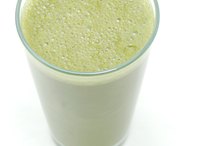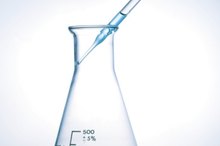What Is Hydrolyzed Soy Protein MSG?
Manufacturers make hydrolyzed soy protein using a process that involves harsh artificial chemicals. The hydrolysis process boils a vat of acid such as sulfuric acid and neutralizes the resulting solution in caustic soda. The byproduct or sludge scraped off the vat and allowed to dry is monosodium glutamate. MSG is the resulting amino-salt, commonly used as a food additive.
MSG and Hydrolyzed Protein
The food industry uses hydrolyzed proteins to add and enhance flavors in manufactured products. The hydrolysis process breaks down the hydrolyzed proteins into amino acids 2. When the broken down proteins form into free glutamate and bond with free sodium, they form MSG. When manufacturers produce MSG through the hydrolysis process, Food and Drug Administration regulations do not require the manufacturers to list MSG as an ingredient on the packaged food product.
- The food industry uses hydrolyzed proteins to add and enhance flavors in manufactured products.
- The hydrolysis process breaks down the hydrolyzed proteins into amino acids 2.
What Is MSG and Where Does It Come From?
What Is MSG Made Of?
Learn More
MSG is one of many forms of glutamic acid, a naturally occurring amino acid found in foods and in your body. Most commercial MSG comes from the fermentation of sugar beets, molasses, sugar cane or starch. When producing commercial MSG, manufacturers only add the natural L-glutamate as a flavoring agent. You can also find glutamic acid and its salts in hydrolyzed vegetable proteins, protein isolates and yeast extract 2.
- MSG is one of many forms of glutamic acid, a naturally occurring amino acid found in foods and in your body.
- You can also find glutamic acid and its salts in hydrolyzed vegetable proteins, protein isolates and yeast extract 2.
Is Allergy to MSG The Same as Hydrolyzed Vegetable Protein?
Some individuals with allergies to MSG can have the same allergic reaction to hydrolyzed vegetable proteins such as soy. Even though manufacturers are not required to label the MSG content in hydrolyzed soy products, according to “The Whole Soy Story,” these products typically contain a significant amount of MSG. Symptoms of an allergic reaction to MSG include:
- headaches
- nausea
- chest pain
- rapid heart rate,
- facial pressure or tightness
If you experience these symptoms after consuming a hydrolyzed soy product, you may have an allergy to MSG, and you should not consume it or any hydrolyzed soy product.
Labeling
Is Monosodium Glutamate a Gluten?
Learn More
The FDA has many rules regarding product labeling. However, manufacturers continually find ways to circumvent these product labeling rules. For example, if a food label states No Added MSG, No MSG Added or No MSG the food product can still have MSG in it without violating labeling rules. As long as the MSG was not directly added to the product, the manufacturer can use this loophole to avoid listing MSG as an ingredient. If a product contains any hydrolyzed vegetable protein it contains some amount of MSG 2.
- The FDA has many rules regarding product labeling.
- As long as the MSG was not directly added to the product, the manufacturer can use this loophole to avoid listing MSG as an ingredient.
Related Articles
References
- "The Whole Soy Story: The Dark Side of America's Favorite Health Food"; Kaayla T. Daniel; 2005
- "Protein Hydrolysates in Biotechnology"; Vijai K. Pasupuleti and Arnold L. Demain; 2010
Writer Bio
Jessica Jacobs is a registered dietitian and professional writer, contributing to "Fitness Magazine" since 2003. She received a B.A. in journalism from Arizona State University and an M.S. in nutrition and food sciences from the University of Texas at Austin.









